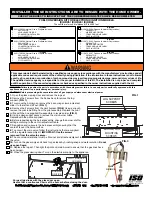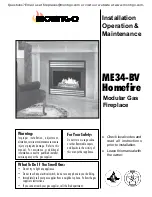
R
R
R
February 3, 2010
7014-188B
Page 11
CB1200-I Pellet Insert
G. Calculating Alternate Floor Protection Material
Thermal Conductivity: k value
The k value indicates the amount of heat (in BTU’s) that will flow
in 1 hour through 1 square foot of a uniform material 1 inch thick
for each degree (F) of temperature difference from one side of
the material to the other. The LOWER the k factor means less
heat is being conducted through the non-combustible material to
the combustible material beneath it. The k value of a material
must be equal or smaller then the required k value to be accept
-
able.
(BTU) (inch)
(foot
2
(hour) (
o
F)
Thermal Resistance: R value
The R value is a measure of a material’s resistance to heat
transfer. R value is convenient when more than one materi
-
al is used since you can add the R values together, whereas
you can not do this for k value. The HIGHER the R factor
means less heat is being conducted through the non-com
-
bustible material to the combustible material beneath it. The
R value of a material must be equal or larger then the re
-
quired R value to be acceptable.
Converting k to R:
Divide 1 by k and multiply the results times the thickness in inch
-
es of the material.
R = 1/k x inches of thickness
Converting R to k:
Divide the inches of thickness by R.
k = inches of thickness/R
Calculations:
Example: Floor protection requires k value of 0.84 and 3/4 inch
thick.
Alternative material has a k value of 0.6 and is 3/4 inch thick.
Divide 0.6 by .75 = k value of 0.80. This k value is smaller than
0.84 and therefore is acceptable.
H. Prefabricated Metal Chimney
The chimney can be new or existing, masonry or prefabricated
and must meet the following minimum requirements:
• Must be minimum 6 inch (152mm) inside diameter of
high temperature chimney listed to UL 103 HT (2100
o
F)
or ULC-S628.
• Must use components required by the manufacturer for
installation.
• Must maintain clearances required by the manufacturer
for installation.
• Refer to manufacturers instructions for installation
•This insert is listed to UL 1482 Standard and is approved
for installation into listed factory-built zero clearance fire
-
places listed to UL 127 conforming to the following speci
-
fications and instructions:
•The original factory-built clearance fireplace chimney
cap must be re-installed after installing the approved
chimney liner meeting type UL 103 HT requirements
(2100°F) per UL 1777.
•If the chimney is not listed as meeting HT requirements,
or if the factory built fireplace was tested prior to 1998, a
full height listed chimney liner must be installed from the
appliance flue collar to the chimney top.
•The liner must be securely attached to the insert flue collar
and the chimney top.
•The air flow of the factory-built zero-clearance fireplace
system must not be altered. The flue liner top support
attachment must not reduce the air flow for the existing
air-cooled chimney system.
•No dilution air is allowed to enter the chimney.
1. Secure the fireplace damper in the open position. If
this cannot be accomplished, it will be necessary to
remove the damper
2. Seal damper area of chimney around chimney
connector with a high temperature sealant or seal
insert against the face of the fireplace.
3. Both methods must be removable and replaceable
for cleaning and re-installation.












































